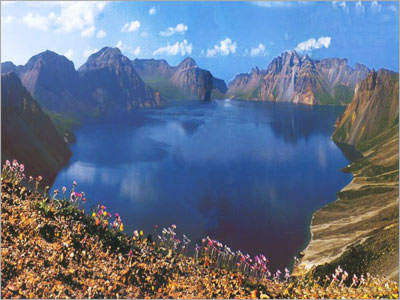China abounds in rivers. More than 1,500 rivers each drain 1,000
sq km or larger areas. Most of the large rivers have their source
on the Qinghai-Tibet Plateau, and drop greatly between source and
mouth. As a result, China is rich in water-power resources, leading
the world in hydropower potential, with reserves of 680 million
kw.
China's rivers can be categorized as exterior and interior
systems. The catchment area of the exterior rivers that empty into
the oceans accounts for 64 percent of the country's total land
area. The Yangtze, Yellow, Heilong, Pearl, Liaohe, Haihe and Huaihe
rivers flow east, and empty into the Pacific Ocean. The
Yarlungzangbo River in Tibet, which flows first east and then south
into the Indian Ocean, boasts the Yarlungzangbo Grand Canyon, the
largest canyon in the world, 504.6 km long and 6,009 m deep. The
Ertix River flows north from the Xinjiang Uygur Autonomous Region
to the Arctic Ocean. The catchment area of the interior rivers that
flow into inland lakes or disappear into deserts or salt marshes
makes up about 36 percent of China's total land area. The Tarim
River, 2,179 km long, in southern Xinjiang is China's longest
interior river.
The Yangtze, 6,300 km long, is the largest river in China, and
the third largest in the world, next only to the Nile in Africa and
the Amazon in South America. Passing through high mountains and
deep valleys, the upper section of the Yangtze River is abundant in
water resources. Known as the "golden waterway," the Yangtze is a
transportation artery linking west and east with its excellent
navigation channel. The middle and lower Yangtze River areas have a
warm and humid climate, plentiful rainfall and fertile soil, making
them important agricultural regions. The Yellow River is the second
largest river in China with a length of 5,464 km. The Yellow River
valley was one of the birthplaces of ancient Chinese civilization.
It has lush pasturelands along its banks, flourishing agriculture
and abundant mineral deposits. The Heilong River is a large river
in north China with a total length of 4,350 km, of which, 3,101 km
are in China. The Pearl River (Zhujiang), 2,214 km long, is a large
river in south China. In addition to those bestowed by nature,
China has a famous man-made river - the Grand Canal, running from
Beijing in the north to Hangzhou in Zhejiang Province in the south.
Work first began on the Grand Canal as early as in the fifth
century BC It links five major rivers: the Haihe, Yellow, Huaihe,
Yangtze and Qiantang. With a total length of 1,801 km, the Grand
Canal is the longest as well as the oldest man-made waterway in the
world.
 |
China's territory includes numerous lakes, most of which are
found on the Middle-Lower Yangtze Plain and the Qinghai-Tibet
Plateau. Freshwater lakes such as Poyang, Dongting, Taihu and
Hongze mostly lie in the former area, while in the latter are
saltwater lakes, such as Qinghai, Nam Co and Siling Co. Poyang
Lake, in the north of Jiangxi Province and with an area of 3,583 sq
km, is the largest of its kind. Qinghai Lake, in northeast Qinghai
Province and with an area of 4,583 sq km, is the largest one of its
kind.